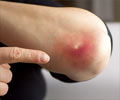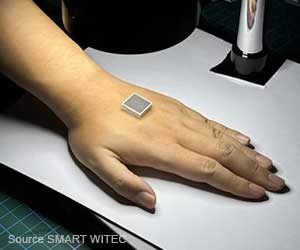Microneedle biosensor can accurately detect patient's antibiotic levels in real time, reveals a new study.

TOP INSIGHT
Tiny non-invasive patches worn on the skin can accurately detect patient's antibiotic levels in real time.
Their findings show the sensors enable real-time monitoring of changes in antibiotic concentration in the body, with similar results to those obtained from blood tests.
The team believes the technology could change how patients with serious infections are treated by showing how quickly their bodies 'use up' medications they are given. The researchers add that if future development and testing proves successful and the technology reaches the clinic, it could help to cut costs for the NHS, reduce drug-resistant infections and improve treatment for patients with life-threatening infections and improve the management of less serious ones.
They add that biosensors could reduce the need for blood sampling and analysis as well as offer more efficient, personalized drug delivery that could potentially be delivered outside of the hospital setting for outpatients.
Dr Timothy Rawson, from Imperial's Department of Infectious Disease and who led the research, said: "Microneedle biosensors hold a great potential for monitoring and treating the sickest of patients. When patients in hospital are treated for severe bacterial infections the only way we have of seeing whether antibiotics we give them are working is to wait and see how they respond, and to take frequent blood samples to analyze levels of the drugs in their system - but this can take time.
Microneedle biosensors use a series of microscopic 'teeth' to penetrate the skin and detect changes in the fluid between cells. These teeth act as electrodes to detect changes in pH and can be coated with enzymes which react with a drug of choice, altering the local pH of the surrounding tissue if the drug is present.
In a small proof-of-concept trial, the Imperial team trialed the sensors in 10 healthy patients who were given doses of penicillin. Sensor patches (1.5 cm sq) were placed on their forearms and connected to monitors, with measurements taken frequently - from 30 minutes before receiving oral penicillin, to four hours afterwards. Blood samples were taken at the same time points for comparison.
Data collected from nine patients revealed that the sensors could accurately detect the changing concentration of penicillin in patients' bodies. The researchers found that while penicillin concentrations varied widely from patient to patient, the overall readings from the biosensors were similar to those from blood samples - showing a marked decrease in drug concentration over time.
According to the team, the early findings are positive, but they explain the study is limited by the very small sample size and the was only tested on a single antibiotic, in healthy patients.
The research team explains that along with further testing in larger patient groups to strengthen the initial findings, they will look to see how the sensors could help to optimize the dosing of penicillin and similar antibiotics. They add that the sensors could form the basis of a 'closed loop system', like an insulin pump - where antibiotics are administered to patients and levels continuously monitored to ensure they receive a sufficient dose.
Professor Tony Cass, from the Department of Chemistry said: "This small, early-stage trial has shown that the sensor technology is as effective as gold standard clinical analysis in detecting changes to the concentrations of penicillin in the human body. When further developed, this technology could prove critical for the monitoring and treatment of patients with severe infections. More widely it could be used to monitor many other drugs and personalize treatment in many diseases"
The technology was developed through research supported by funding from the National Institute for Health Research (NIHR) and Fondation Merieux. Volunteers were recruited and treated at the NIHR Imperial Biomedical Research Centre at Imperial College Healthcare NHS Trust. This collaborative work will be advanced further through Imperial's National Centre for Antimicrobial Research and Optimisation (CAMO).
Professor Alison Holmes, from Imperial's Department of Infectious Disease and director of the NIHR Health Protection Research Unit in HCAI and AMR at Imperial and the CAMO, said: "This technology is an example of the close collaboration between scientists, medics and engineers going on in institutions across the UK, which could change the way we treat patients. Antibiotic resistance and drug-resistant infections are among the biggest threats to human health in the world today."
Professor Holmes added: "Technological solutions such as our microneedle biosensor could prove crucial in improving how we use and protect the arsenal of life-saving antibiotics we have available to treat patients. Ultimately, these types of collaborative, multidisciplinary solutions could lead to earlier detection and better treatment of infections, helping to save more lives and protect these invaluable medicines for generations to come."
Source-Eurekalert
 MEDINDIA
MEDINDIA




 Email
Email









